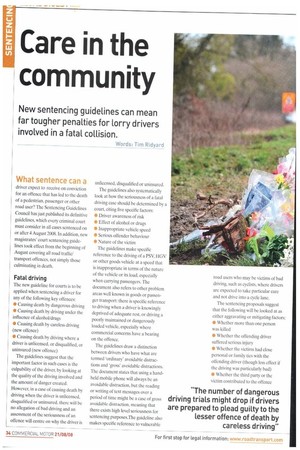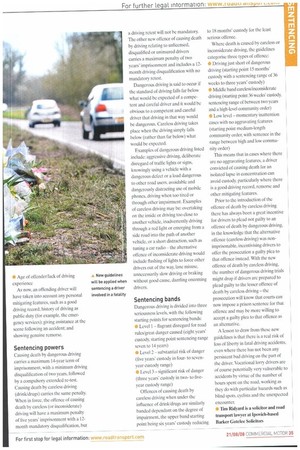Care in the community
Page 34

Page 35

If you've noticed an error in this article please click here to report it so we can fix it.
New sentencing guidelines can mean far tougher penalties for lorry drivers involved in a fatal collision.
Words: Tim Ridyard
What sentence can a
driver expect to receive on conviction for an offence that has led to the death of a pedestrian, passenger or other road user? The Sentencing Guidelines Council has just published its definitive guidelines, which every criminal court must consider in all cases sentenced on or after 4 August 2008. In addition, new magistrates' court sentencing guidelines took effect from the beginning of August covering all road traffic/ transport offences, not simply those culminating in death.
Fatal driving
The new guideline for courts is to be applied when sentencing a driver for any of the following key offences: • Causing death by dangerous driving • Causing death by driving under the influence of alcohol/drugs • Causing death by careless driving new offence) • Causing death by driving where a driver is unlicensed, or disqualified, or uninsured (new offence) The guidelines suggest that the important factor in such cases is the culpability of the driver, by looking at the quality of the driving involved and the amount of danger created. However, in a case of causing death by driving when the driver is unlicensed, disqualified or uninsured, there will be no allegation of bad driving and an assessment of the seriousness of an offence will centre on why the driver is unlicensed, disqualified or uninsured.
The guidelines also systematically look at how the seriousness of a fatal driving case should be determined by a court, citing five specific factors: • Driver awareness of risk • Effect of alcohol or drugs • Inappropriate vehicle speed • Serious offender behaviour • Nature of the victim The guidelines make specific reference to the driving of a PSV, HGV or other goods vehicle at a speed that is inappropriate in terms of the nature of the vehicle or its load, especially when carrying passengers. The document also refers to other problem areas well known in goods or passenger transport: there is specific reference to driving when a driver is knowingly deprived of adequate rest, or driving a poorly maintained or dangerously loaded vehicle, especially where commercial concerns have a bearing on the offence.
The guidelines draw a distinction between drivers who have what are termed 'ordinary' avoidable distractions and 'gross' avoidable distractions. The document states that using a handheld mobile phone will always be an avoidable distraction, but the reading or writing of text messages over a period of time might be a case of gross avoidable distraction, meaning that there exists high level seriousness for sentencing purposes.The guideline also makes specific reference to vulnerable road users who may be victims of bad driving, such as cyclists, where drivers are expected to take particular care and not drive into a cycle lane.
The sentencing proposals suggest that the following will be looked at as either aggravating or mitigating factors: • Whether more than one person was killed • Whether the offending driver suffered serious injury • Whether the victims had close personal or family ties with the offending driver (though less effect if the driving was particularly bad) • Whether the third party or the victim contributed to the offence • Age of offender/lack of driving experience As now, an offending driver will have taken into account any personal mitigating features, such as a good driving record; history of driving as public duty (for example. the emergency services); giving assistance at the scene following an accident; and showing genuine remorse.
Sentencing powers
Causing death by dangerous driving carries a maximum 14-year term of imprisonment, with a minimum driving disqualification of two years, followed by a compulsory extended re-test. Causing death by careless driving (drink/drugs) carries the same penalty. When in force, the offence of causing death by careless (or inconsiderate) driving will have a maximum penalty of live years' imprisonment with a 12month mandatory disqualification, hut _ a driving retest will not be mandatory. The other new offence of causing death by driving relating to unlicensed, disqualified or uninsured drivers carries a maximum penalty of two years' imprisonment and includes a 12month driving disqualification with no mandatory retest.
Dangerous driving is said to occur if the standard of driving falls far below what would be expected of a competent and careful driver and it would be obvious to a competent and careful driver that driving in that way would be dangerous. Careless driving takes place when the driving simply falls below (rather than far below) what would be expected.
Examples of dangerous driving listed include: aggressive driving, deliberate disregard of traffic lights or signs, knowingly using a vehicle with a dangerous defect or a load dangerous to other road users, avoidable and dangerously distracting use of mobile phones, driving when too tired or through other impairment. Examples of careless driving may be: overtaking on the inside or driving too close to another vehicle, inadvertently driving through a red light or emerging from a side road into the path of another vehicle, or a short distraction, such as tuning a car radio the alternative offence of inconsiderate driving would include flashing of lights to force other drivers out of the way, lane misuse, unnecessarily slow driving or braking without good cause, dazzling oncoming drivers.
Sentencing bands
Dangerous driving is divided into three seriousness levels, with the following starting points for sentencing bands: • Level 1 flagrant disregard for road rules/great danger caused (eight years' custody, starting point sentencing range seven to 14 years) • Level 2 substantial risk of danger (five years' custody in fourto sevenyear custody range) • Level 3 significant risk of danger (three years' custody in twoto fiveyear custody range) Offences of causing death by careless driving when under the influence of drink/drugs are similarly banded dependant on the degree of impairment, the upper band starting point being six years' custody reducing to 18 months' custody for the least serious offence.
Where death is caused by careless or inconsiderate driving, the guidelines categorise three types of offence: • Driving just short of dangerous driving (starting point 15 months' custody with a sentencing range of 36 weeks to three years' custody) • Middle band careless/inconsiderate driving (starting point 36 weeks' custody, sentencing range of between two years and a high-level community order) • Low level momentary inattention cases with no aggravating features (starting point medium-length community order, with sentence in the range between high and low community order) This means that in cases where there are no aggravating features, a driver convicted of causing death for an isolated lapse in concentration can avoid custody, particularly where there is a good driving record, remorse and other mitigating features.
Prior to the introduction of the offence of death by careless driving there has always been a great incentive for drivers to plead not guilty to an offence of death by dangerous driving, in the knowledge that the alternative offence (careless driving) was nonimprisonable, incentivising drivers to offer the prosecution a guilty plea to that offence instead. With the new offence of death by careless driving, the number of dangerous driving trials might drop if drivers are prepared to plead guilty to the lesser offence of death by careless driving the prosecution will know that courts can now impose a prison sentence for that offence and may be more willing to accept a guilty plea to that offence as an alternative.
A lesson to draw from these new guidelines is that there is a real risk of loss of liberty in fatal driving accidents, even where there has not been any persistent bad driving on the part of the driver. Vocational lorry drivers are of course potentially very vulnerable to accidents by virtue of the number of hours spent on the road, working as they do with particular hazards such as blind spots. cyclists and the unexpected encounter.
• Tim Ridyard is a solicitor and road transport lawyer at Ipswich-based Barker Gotelee Solicitors












































































































































































